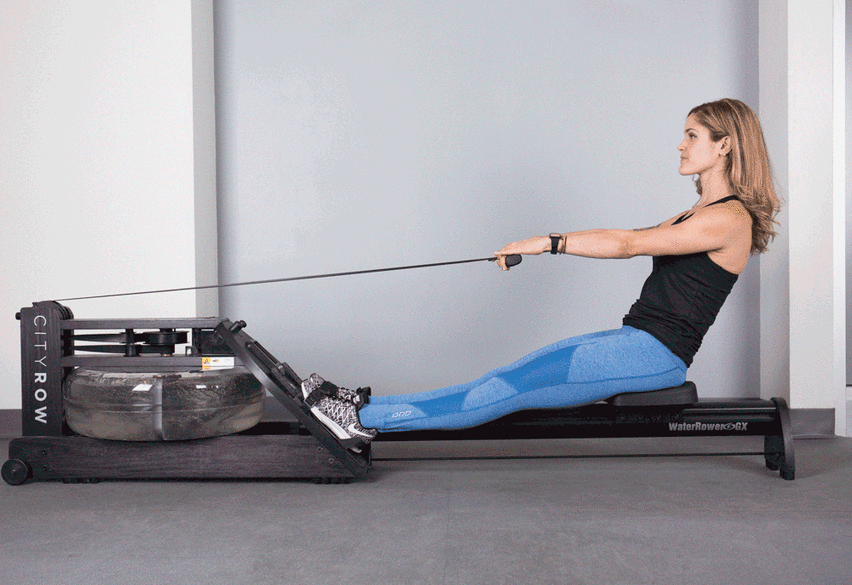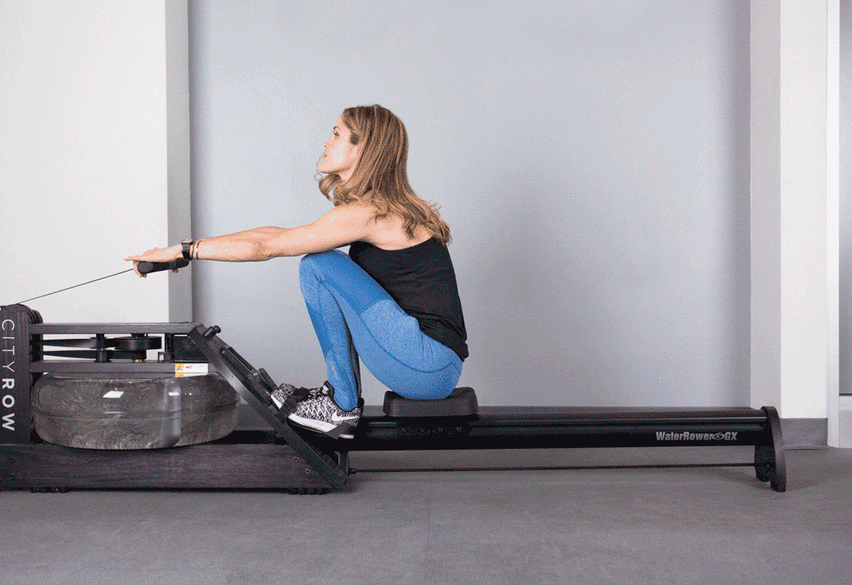Once relegated to the back of the gym, the rowing machine is experiencing a surge in popularity—so much so that there are now entire boutique studios devoted to it and its awesome total-body benefits. But the machine can be intimidating at first. Do I lead with legs or arms? Should my shoulders feel sore? And why do my feet keep slipping out of the straps? You're not alone.

The most important thing to remember is: "It's about power, not speed," says Melody Davi, rowing instructor at City Row in New York City. If you walk out of a rowing class with a sore back, you're doing it wrong, Davi says. Instead focus on using your lower-body powerhouse muscles—glutes, hamstrings, quads—to push yourself out and then gently glide back in.
Before we dive into more technique, here are two terms that will help guide your workout:

Strokes per minute: How many times you row (stroke) in 1 minute. Keep this number at 30 or less, Davi says. Remember: It's about power, not just flinging your body back and forth.
Split time: The amount of time it takes to row 500 meters. Aim for 2 minutes or less. To increase your pace, push out with more power; don't just pump your arms faster.
3 Steps to the Perfect Row

Start by holding the oar with arms extended, knees bent, and weight on the balls of your feet (this position is called the "catch"). With back straight and core engaged, push back using only legs, rolling through feet so they are flat when legs are extended. Keep arms extended throughout.

After you've gotten used to pushing with your lower body, practice arm isolations. With legs straight, pull oar toward chest. Bend elbows out to sides and touch oar just under chest. Hold the oar lightly (more on that below) and use upper back (not shoulders or biceps) to pull oar toward you. Engage the same muscles as you do for a push-up or bent-over row.

It's time to put everything together! With back straight, core engaged, and balls of feet firmly in straps, push back first with lower body then use upper back to pull hands toward chest. Next, release arms toward the base and bend knees so you glide back to starting position.
Think: legs, arms, arms, legs. Another tip? Take one beat to push out and two beats to glide back, Davi says. In other words, your move back should be twice as fast as your return to starting position.
5 Common Rowing Mistakes (and How to Fix Them!)


In catch, push shoulders back (to open chest) and down (so there's no tension around neck). Keep back straight by engaging core and breathing deeply (trust us, it's hard to take deep breaths when you've got bad posture).

If you bend knees before arms are fully extended on the return, you'll need to make this scooping motion to avoid hitting legs with the oar. Rowing is a chain reaction, so one poor form choice can lead to another.

Don't decapitate yourself with the oar! Pulling the oar all the way up to your chin isn't just bad form; it probably means you're using more energy than what's necessary, Davi says.

Use upper-back muscles to pull the oar toward chest. At the end of each row, elbows should be bent more than 90 degrees and forearms should be even with rib cage.





Place your hands on the outside of the oar (not the center). Float pinky fingers off the end and rest thumbs on top (don't wrap them around). Hold the oar with the first, middle, and ring fingers of each hand.
Every time you pull back, remember to use your upper back, not shoulders and biceps. This will help take the pressure off your hands.
Special thanks to Melody Davi, instructor at City Row, who modeled perfect rowing form for us. Davi wears a C9 by Champion top, Lorna Jane leggings, and her own Nike sneakers.

Original article and pictures take http://greatist.com/move/how-to-use-a-rowing-machine site

Комментариев нет:
Отправить комментарий